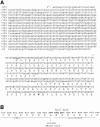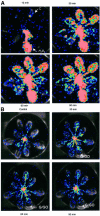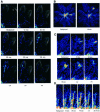Stress induces peroxisome biogenesis genes
- PMID: 11118212
- PMCID: PMC305880
- DOI: 10.1093/emboj/19.24.6770
Stress induces peroxisome biogenesis genes
Abstract
Peroxisomes are the cellular location of many antioxidants and are themselves significant producers of reactive oxygen species. In this report we demonstrate the induction of peroxisome biogenesis genes in both plant and animal cells by the universal stress signal molecule hydrogen peroxide. Using PEX1-LUC transgenic plants, rapid local and systemic induction of PEX1-luciferase could be demonstrated in vivo in response to physiological levels of hydrogen peroxide. PEX1-luciferase was also induced in response to wounding and to infection with an avirulent pathogen. We propose a model in which various stress situations that lead to the production of hydrogen peroxide can be ameliorated by elaboration of the peroxisome compartment to assist in restoration of the cellular redox balance.
Figures






Similar articles
-
Heterologous expression of a chloroplast outer envelope protein from Suaeda salsa confers oxidative stress tolerance and induces chloroplast aggregation in transgenic Arabidopsis plants.Plant Cell Environ. 2012 Mar;35(3):588-600. doi: 10.1111/j.1365-3040.2011.02438.x. Epub 2011 Nov 3. Plant Cell Environ. 2012. PMID: 21988377
-
A subcellular localization compendium of hydrogen peroxide-induced proteins.Plant Cell Environ. 2012 Feb;35(2):308-20. doi: 10.1111/j.1365-3040.2011.02323.x. Epub 2011 Apr 28. Plant Cell Environ. 2012. PMID: 21443605
-
A wheat lipid transfer protein 3 could enhance the basal thermotolerance and oxidative stress resistance of Arabidopsis.Gene. 2014 Oct 15;550(1):18-26. doi: 10.1016/j.gene.2014.08.007. Epub 2014 Aug 5. Gene. 2014. PMID: 25106859
-
Are diverse signalling pathways integrated in the regulation of arabidopsis antioxidant defence gene expression in response to excess excitation energy?Philos Trans R Soc Lond B Biol Sci. 2000 Oct 29;355(1402):1531-40. doi: 10.1098/rstb.2000.0713. Philos Trans R Soc Lond B Biol Sci. 2000. PMID: 11128006 Free PMC article. Review.
-
Epigenetic regulation in the control of flowering.Cold Spring Harb Symp Quant Biol. 2004;69:457-64. doi: 10.1101/sqb.2004.69.457. Cold Spring Harb Symp Quant Biol. 2004. PMID: 16117681 Review. No abstract available.
Cited by
-
Ozone-induced H2 O2 accumulation in field-grown aspen and birch is linked to foliar ultrastructure and peroxisomal activity.New Phytol. 2004 Mar;161(3):791-799. doi: 10.1111/j.1469-8137.2003.00981.x. New Phytol. 2004. PMID: 33873720
-
Drought stress and reactive oxygen species: Production, scavenging and signaling.Plant Signal Behav. 2008 Mar;3(3):156-65. doi: 10.4161/psb.3.3.5536. Plant Signal Behav. 2008. PMID: 19513210 Free PMC article.
-
Study of natural diversity in response to a key pathogenicity regulator of Ralstonia solanacearum reveals new susceptibility genes in Arabidopsis thaliana.Mol Plant Pathol. 2022 Mar;23(3):321-338. doi: 10.1111/mpp.13135. Epub 2021 Dec 23. Mol Plant Pathol. 2022. PMID: 34939305 Free PMC article.
-
Peroxisomes contribute to reactive oxygen species homeostasis and cell division induction in Arabidopsis protoplasts.Front Plant Sci. 2015 Aug 26;6:658. doi: 10.3389/fpls.2015.00658. eCollection 2015. Front Plant Sci. 2015. PMID: 26379686 Free PMC article.
-
New Genes Involved in Osmotic Stress Tolerance in Saccharomyces cerevisiae.Front Microbiol. 2016 Sep 28;7:1545. doi: 10.3389/fmicb.2016.01545. eCollection 2016. Front Microbiol. 2016. PMID: 27733850 Free PMC article.
References
-
- Albertini M., Rehling,P., Erdmann,R., Girzalsky,W., Kiel,J.A.K.W., Veenhuis,M. and Kunau,W.-H. (1997) Pex14p, a peroxisomal membrane protein binding both receptors of the two PTS-dependent protein import pathways. Cell, 89, 83–92. - PubMed
-
- Alvarez M.E., Pennell,R.I., Meier, P.-J., Ishikawa,A., Dixon,R.A. and Lamb,C. (1998) Reactive oxygen intermediates mediate a systemic signal network in the establishment of plant immunity. Cell, 92, 773–784. - PubMed
-
- Barroso J.B., Corpas,F.J., Carreras,A., Sandalio,L.M., Valderrama,R., Palma,J.M., Lupianez,J.A. and del Rio,L.A. (1999) Localization of nitric-oxide synthase in plant peroxisomes. J. Biol. Chem., 274, 36729–36733. - PubMed
-
- Brickner D.G., Brickner,J.H. and Olsen,L.J. (1998) Sequence analysis of a cDNA encoding Pex5p, a peroxisomal targeting signal type 1 receptor from Arabidopsis thaliana (accession no. AF074843). Plant Physiol., 118, 330.
-
- Creelman R.A and Mullet,J.E (1997) Biosynthesis and action of jasmonates in plants. Annu. Rev. Plant Physiol. Plant Mol. Biol., 48, 355–381. - PubMed
Publication types
MeSH terms
Substances
LinkOut - more resources
Full Text Sources
Other Literature Sources
Molecular Biology Databases

